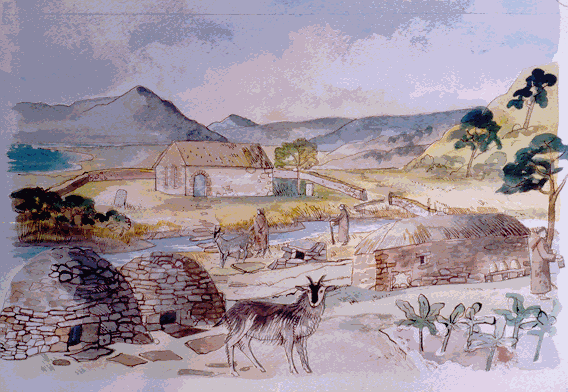
Early Medieval Dornoch
St Finbarr and the arrival of Christianity
The figure traditionally associated with bringing Christianity to the Dornoch area is Saint Finbarr of Caithness and Ulster. Finbarr may have arrived in Dornoch c.540 AD and established a muintirr or settlement there. Possible evidence of this settlement was found on Schoolhill at the beginning of the 20th century and in what may have been the ruins of his church at the east end of the Cathedral graveyard.
Place-names in and around Dornoch reflect the saint’s association with the town: Templebar (the reputed site of his church); Cnoc Varr (where he went to pray); and Davochfin. Dornoch’s 13th century Cathedral was originally dedicated to the saint, while the town’s most important annual trading fair was St Barr’s Fair, originally held on 10 September, the date of Finbarr of Ulster’s birthday.
Possible 6th-century view of Dornoch.
 If Finbarr did establish a Christian community in Dornoch during the 6th century, then it is likely that it may not have survived the Norse incursions of the mid-to-late 9th century when the Vikings settled in Caithness and Sutherland. There are unsubstantiated indications that St Duthac of Tain may have been ministering in the Dornoch area during the 11th century, but the only proof that any religious settlement might have existed in the area come from an instruction by David I (dated c.1136) to the Norse Earl of Orkney and Caithness, warning him to ‘respect and maintain free from harm the monks and their men dwelling in Durnach’. Even this royal command does not provide conclusive proof that there was a permanent settlement in the town; the monks referred to by David may have only been residing temporarily in the area before moving on to another destination
If Finbarr did establish a Christian community in Dornoch during the 6th century, then it is likely that it may not have survived the Norse incursions of the mid-to-late 9th century when the Vikings settled in Caithness and Sutherland. There are unsubstantiated indications that St Duthac of Tain may have been ministering in the Dornoch area during the 11th century, but the only proof that any religious settlement might have existed in the area come from an instruction by David I (dated c.1136) to the Norse Earl of Orkney and Caithness, warning him to ‘respect and maintain free from harm the monks and their men dwelling in Durnach’. Even this royal command does not provide conclusive proof that there was a permanent settlement in the town; the monks referred to by David may have only been residing temporarily in the area before moving on to another destination

